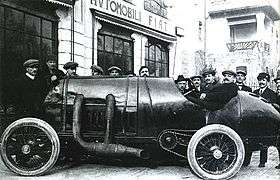Fiat S76 Record
The FIAT S76, later also known as FIAT 300 HP Record and nicknamed "The Beast of Turin", was a car built in 1910 by the Italian company FIAT specifically to beat the land speed record held in those years by the Blitzen Benz. Its 28,353 cc displacement engine delivered 290 hp. Only two examples were built.
| Fiat S76 Record | |
|---|---|
 Fiat S76 Record No. 2, in front of Fiat factory, Turin, 1911 | |
| Overview | |
| Manufacturer | Fiat |
| Production | 1910 |
| Body and chassis | |
| Class | Land speed record vehicle |
| Powertrain | |
| Engine | Fiat S.76 (28.5-liter, 290-hp, inline-four cylinder engine) |
| Dimensions | |
| Length | 3,750 mm (147.6 in) |
| Width | 1,300 mm (51.2 in) |
| Curb weight | 1,650 kg (3,638 lb) |
Technical Features
The S76 had a 4-cylinder engine with a displacement of 28,353 cm3 (1,730.2 in3) (190 mm × 250 mm), providing 290 metric horsepower (210 kW) at 1900 rpm, compressed air starting with 3 spark plugs per cylinder, ignition with low voltage magnet, water cooling, transmission with chain, axle suspension rigid with front and rear leaf springs (rear longitudinal struts), 4-speed gearbox plus reverse gear.
The radiator design of this "prototype" for records was reused by FIAT for subsequent road models.
The S76 had a maximum speed of 132.27 mph (213 km/h).
History
The first S76 was constructed in 1910 and kept by Fiat. It was tested by Felice Nazzaro, who considered the 38 short cwt (1,700 kg) car ‘uncontrollable'. The second S76 was sold by Fiat to Russian Prince Boris Soukhanov, in 1911. Soukhanov originally hired Pietro Bordino to drive the car on the Brooklands motor racing circuit in Weybridge, Surrey, England. Bordino refused to drive the car faster than 90 mph. It was later driven at the Saltburn Sands beach near Redcar & Cleveland, England, where it reached speeds of 116 mph (187 km/h). Soukhanov then hired American driver Arthur Duray in a December 1913 land speed record attempt at Ostende, Belgium. Duray managed a one-way speed of 132.27 mph (213 km/h), but was unable to complete a return run within the hour allotted. The Beast of Turin was granted an unofficial title of world's fastest car due to this speed, but not made official due to being unable to complete the run within the time limit.
Following the First World War, the first S76 built was dismantled by Fiat at the end of 1919. Soukhanov's S76, missing its engine, ended up in Australia, where it was rebuilt and re-powered with a Stutz engine. The S76's career ended when it was crashed at Armadale in the early 1920s while practicing for a race to the coast. In the 1950s, it ended up in Stuart Middlehurst's, an early collector, hands. Middlehurst took the S76's Rudge wheels and hubs to restore one of his Hispano-Suizas. Middlehurst then gave the chassis to Neville Roberts. The chassis was later purchased by Brian Arundale in the 1980s, who identified it as the S76, but no major restoration work was made.
Duncan Pittaway obtained the chassis of Soukhanov's S76 in 2003 and had it shipped to the UK. After the discovery of the surviving S76 engine from the sister car, Pittaway started the rebuild of the S76. Three major parts of the car needed to be recreated from scratch including: The double chain-drive gearbox, the body, and the radiator. All were created by referencing original Fiat drawings, and period photographs. In November 2014, Pittaway and a team of motorists managed to return the S76's engine to working order, although more work was needed before the car was fully operational again. This was completed in 2015 and the "Beast of Turin" was displayed and driven for the first time in almost a century at the Goodwood Festival of Speed between 23 – 26 June 2015.
It has since been displayed and competed at the Chateau Impney Hill Climb during 11-12 July 2015 and the Prescott Speed Hill Climb in May 2016.
References
- What a 28.5-liter LSR engine sounds like firing up for the first time in 100 years - Chris Bruce, Autoblog, 02/12/2014
- - Dopo 100 anni risorge la Fiat S76 300 HP Record
- After a 100-year slumber, the Beast of Turin comes to life - Kurt Ernst, Hemmings, 12/04/2014
- The Monster is Stirring – The Rebirth of a 1729 Cubic Inch S.76 Fiat The Old Motor, 5/03/2014
- The Beast of Turin awakens: Fiat S76 driven for the first time in a century -- and it’s very, very angry Graham Kozak, Autoweek, 15 March 2015
- The Beast Of Turin Captivates Crowds at 2015's Chateau Impney Hill Climb 24 March 2016
- RE: Fiat S76 (merged) Duncan Pittaway 2 July 2007 - 10:29
- RE: Fiat S76 (merged) John Medley 23 June 2015 - 23:06
- The Monster The Old Motor 24 March 2011